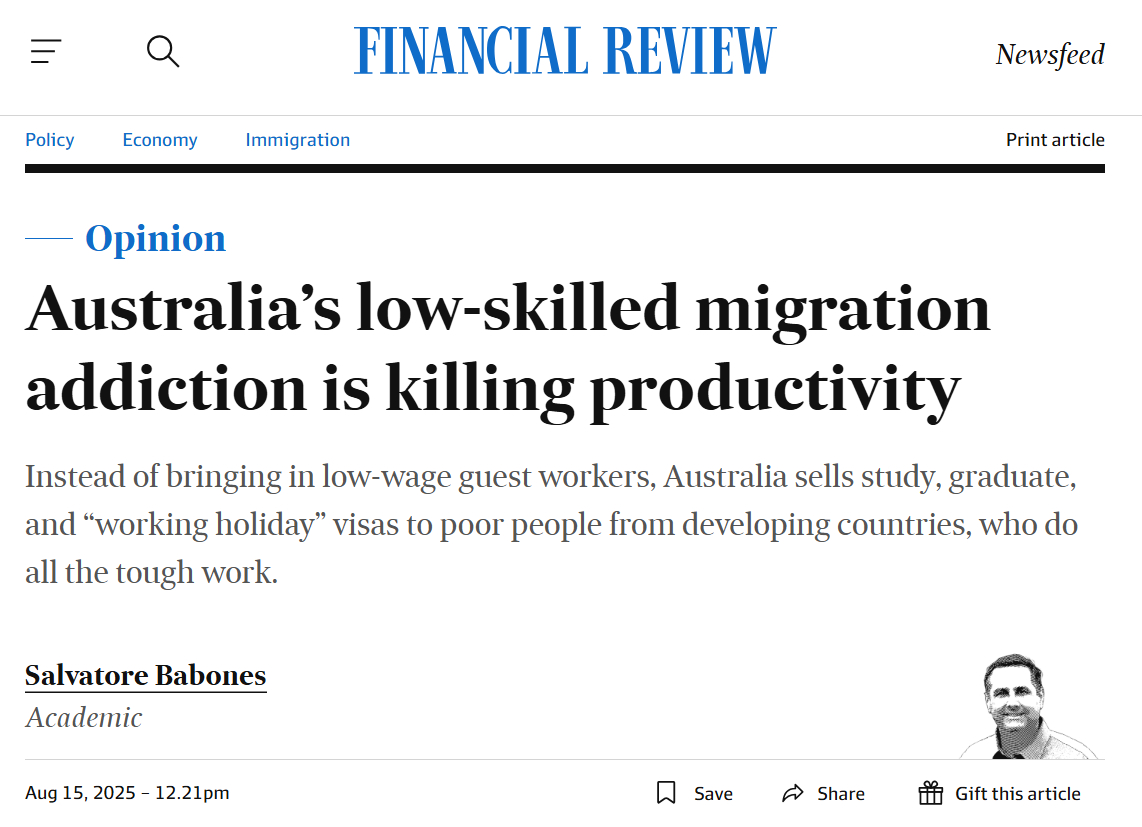Australia's One Forbidden Word
Low-skill immigration is at the root of Australia's productivity malaise
Australia’s real GDP per hour worked hasn’t grown in a decade—or to be more specific, it has recently fallen back to 2016 levels. The mandarins at the Treasury, the Reserve Bank, and the Productivity Commission are mystified by Australia's stubbornly low productivity. The Productivity Commission lists a "mix" of causes for the productivity malaise ranging from the rise of the services sector to a lack of private investment. But there's one word that's not even mentioned in its 17-page report on the problem, or in the Reserve Bank's recent analysis of the “drivers” of low productivity growth. It's the forbidden word. Immigration.
Until 2015, productivity growth in Australia followed the business cycle, just like in every other country. Then from 2016-2019 net migration surged, and productivity stalled. When COVID hit, immigration collapsed—and productivity surged. Partly that was due to a sudden contraction in working hours, leading to rising productivity among those who remained in work. But productivity growth peaked at the end of the pandemic, not at its beginning.
Shorn of low-skill workers, the Australian economy experienced its best productivity growth of the last 20 years. This came to a screeching halt when the borders opened. Australia now has 1.8 million more workers than it did in mid-2019. That's an increase of 14% over pre-COVID levels, and nearly all of the increase has come from immigration.
Read my full analysis of the relationship between immigration and productivity growth in this weekend's Australian Financial Review. There you can find all detailed facts and figures on immigration and productivity to support the argument. My article is also available online (though paywalled) at:
It's a simple principle of economics that when you increase the supply of something, the price goes down and it gets used less efficiently. If you flood the market with oil, pump prices will fall and people will take more trips. Restrict the oil supply and pump prices will rise, encouraging people to use petrol more efficiently. The same is true of labour. If you expand the labour supply, real wages (adjusted for inflation) will stagnate, and productivity will decline as labour is used less efficiently. And that's exactly what has happened in Australia since COVID: massive immigration has depressed wage and productivity growth.
The facts are as obvious as the logic. Combining student visas (half of them for non-university study), post-graduate work visas, 3-year “working holiday” visas, and 3-year "work and holiday" visas, foreign youngsters now make up more than 10% of Australia's total labour force—and they're not working high-skill, high-productivity jobs. Anyone living in a capital city who has ever taken an Uber, ordered Uber Eats, visited a restaurant, hired a removalist, needed home care, or driven past a lollipop girl knows the truth: Australia has become a low-skill, low-wage, low-productivity economy, and it's all being driven by immigration.
Here in Australia, we don't like to think of ourselves as living in a guest worker economy. In places like Singapore and Dubai, citizens enjoy government-subsidized lifestyles while poor people from developing countries do all the tough work. So instead of bringing in low-wage guest workers, we sell study, graduate, and "working holiday" visas to poor people from developing countries, who do all the tough work. It's just as exploitative. But it feels better to think that the young people we're exploiting are earning valuable diplomas as they holiday in our restaurant kitchens and deliver our food.
Readers who are focused on the politics of immigration in the United States, be warned (and be informed): Australia is a different country. Among people aged 20-44 in Australia, an incredible 40% of the population is foreign-born. Considering that immigrants work at higher rates than the native born (and that it’s near-impossible difficult to get a visa if you are disabled or otherwise limited in your ability to work), it is likely that immigrants form roughly 50% of the labor force in the 20-44 age bracket.
The mandarins on Macquarie Street and in Canberra may not want to see it, but the reasons for stagnant productivity growth are staring us in the face every day. There are 1.5 million of them, and they're good, hard-working people. But productivity growth means increasing the use of technology, not increasing the amount of manual labour in the economy. Every economist knows that. They just don't want to tell you.
The Salvatore Babones Newsletter will return.


